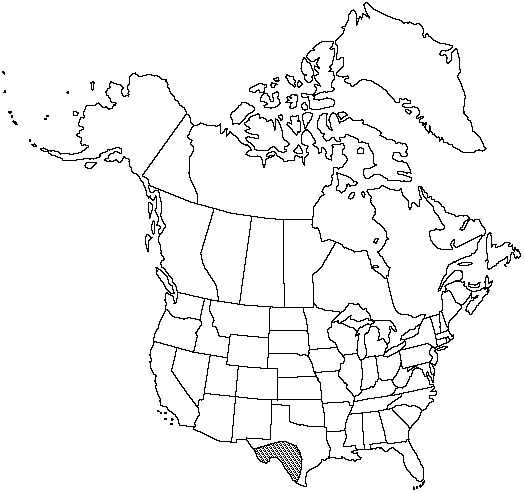Difference between revisions of "Notholaena copelandii"
Amer. Fern J. 40: 181, plate 16. 1950.
FNA>Volume Importer |
FNA>Volume Importer |
||
| Line 25: | Line 25: | ||
}}<!-- | }}<!-- | ||
| − | --><span class="statement" id="st- | + | --><span class="statement" id="st-undefined" data-properties=""><b>Stem </b>scales strongly bicolored, margins brown, broad and well defined, thin, weakly ciliate. <b>Leaves</b> 6–25 cm. <b>Petiole</b> black, equal to or somewhat longer than blade, rounded adaxially, glabrous except for a few scales and farinose glands near base. <b>Blade</b> ovate, 2-pinnate-pinnatifid, 1–2 times longer than wide, abaxially with conspicuous white farina, scales absent, adaxially glandular; basal pinnae much larger than adjacent pair, strongly inequilateral, proximal basiscopic pinnules greatly enlarged. <b>Ultimate</b> segments sessile, broadly adnate to costae; segment margins slightly recurved, rarely concealing sporangia. <b>Sporangia</b> containing 64 spores. <b>2n</b> = 60.</span><!-- |
-->{{Treatment/Body | -->{{Treatment/Body | ||
| + | |phenology=Sporulating summer–fall. | ||
|habitat=Rocky slopes and cliffs, apparently confined to limestone | |habitat=Rocky slopes and cliffs, apparently confined to limestone | ||
|elevation=300–1500 m | |elevation=300–1500 m | ||
| Line 47: | Line 48: | ||
|basionyms= | |basionyms= | ||
|family=Pteridaceae | |family=Pteridaceae | ||
| + | |phenology=Sporulating summer–fall. | ||
|habitat=Rocky slopes and cliffs, apparently confined to limestone | |habitat=Rocky slopes and cliffs, apparently confined to limestone | ||
|elevation=300–1500 m | |elevation=300–1500 m | ||
| Line 54: | Line 56: | ||
|publication year=1950 | |publication year=1950 | ||
|special status= | |special status= | ||
| − | |source xml=https://jpend@bitbucket.org/aafc-mbb/fna- | + | |source xml=https://jpend@bitbucket.org/aafc-mbb/fna-data-curation.git/src/9216fc802291cd3df363fd52122300479582ede7/coarse_grained_fna_xml/V2/V2_256.xml |
|genus=Notholaena | |genus=Notholaena | ||
|species=Notholaena copelandii | |species=Notholaena copelandii | ||
| − | |||
| − | |||
| − | |||
| − | |||
| − | |||
| − | |||
| − | |||
| − | |||
| − | |||
| − | |||
| − | |||
| − | |||
| − | |||
| − | |||
| − | |||
| − | |||
| − | |||
| − | |||
| − | |||
| − | |||
| − | |||
| − | |||
| − | |||
| − | |||
| − | |||
| − | |||
| − | |||
| − | |||
}}<!-- | }}<!-- | ||
-->[[Category:Treatment]][[Category:Notholaena]] | -->[[Category:Treatment]][[Category:Notholaena]] | ||
Revision as of 13:15, 27 July 2019
Stem scales strongly bicolored, margins brown, broad and well defined, thin, weakly ciliate. Leaves 6–25 cm. Petiole black, equal to or somewhat longer than blade, rounded adaxially, glabrous except for a few scales and farinose glands near base. Blade ovate, 2-pinnate-pinnatifid, 1–2 times longer than wide, abaxially with conspicuous white farina, scales absent, adaxially glandular; basal pinnae much larger than adjacent pair, strongly inequilateral, proximal basiscopic pinnules greatly enlarged. Ultimate segments sessile, broadly adnate to costae; segment margins slightly recurved, rarely concealing sporangia. Sporangia containing 64 spores. 2n = 60.
Phenology: Sporulating summer–fall.
Habitat: Rocky slopes and cliffs, apparently confined to limestone
Elevation: 300–1500 m
Discussion
Notholaena copelandii often has been treated as a variety of the Mexican species N. candida (M. Martens & Galeotti) Hooker. The two taxa show significant differences in stem scale and leaf morphology (R. M. Tryon 1956), density of glands on the adaxial leaf surface, and chemical composition of the farinose indument (E. Wollenweber 1984). Measures of genetic similarity based on isozyme data indicate that N. copelandii and N. candida are quite distinct and, at present, allopatry precludes gene flow. Past hybridization may account for the small number of intermediate specimens reported from San Luis Potosí, Mexico, by R. M. Tryon (1956).
Selected References
None.
